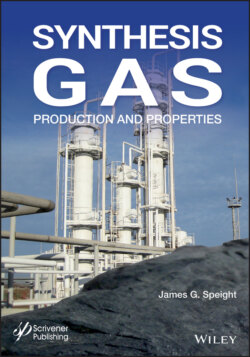Читать книгу Synthesis Gas - James Speight G., James G. Speight - Страница 62
2.6.1.4 Synthesis Gas
ОглавлениеSynthesis gas is a mixture mainly of hydrogen and carbon monoxide which is comparable in its combustion efficiency to natural gas (Speight, 2008 Chapter 7). This reduces the emissions of sulfur, nitrogen oxides, and mercury, resulting in a much cleaner fuel (Nordstrand et al., 2008; Lee et al., 2006; Sondreal et al., 2004, 2006; Yang et al., 2007; Wang et al., 2008). The resulting hydrogen gas can be used for electricity generation or as a transport fuel. The gasification process also facilitates capture of carbon dioxide emissions from the combustion effluent (see discussion of carbon capture and storage below).
Although synthesis gas can be used as a stand-alone fuel, the energy density of synthesis gas is approximately half that of natural gas and is therefore mostly suited for the production of transportation fuels and other chemical products. Synthesis gas is mainly used as an intermediary building block for the final production of various fuels such as synthetic natural gas, methanol, and synthetic fuel (dimethyl ether – synthesized gasoline and diesel fuel) (Chadeesingh, 2011; Speight, 2013).
The use of synthesis gas offers the opportunity to furnish a broad range of environmentally clean fuels and chemicals and there has been steady growth in the traditional uses of synthesis gas. Almost all hydrogen gas is manufactured from synthesis gas and there has been an increase in the demand for this basic chemical. In fact, the major use of synthesis gas is in the manufacture of hydrogen for a growing number of purposes, especially in crude oil refineries (Speight, 2014a, 2017). Methanol not only remains the second-largest consumer of synthesis gas but has shown remarkable growth as part of the methyl ethers used as octane enhancers in automotive fuels.
The Fischer-Tropsch synthesis remains the third-largest consumer of synthesis gas, mostly for transportation fuels but also as a growing feedstock source for the manufacture of chemicals, including polymers. The hydroformylation of olefins (the Oxo reaction), a completely chemical use of synthesis gas, is the fourth-largest use of carbon monoxide and hydrogen mixtures. A direct application of synthesis gas as fuel (and eventually also for chemicals) that promises to increase is its use for integrated gasification combined cycle (IGCC) units for the generation of electricity (and also chemicals) from coal, crude oil coke or high-boiling (high-density) resids. Finally, synthesis gas is the principal source of carbon monoxide, which is used in an expanding list of carbonylation reactions, which are of major industrial interest.
Since the synthesis gas is at high pressure and has a high concentration of carbon dioxide, a physical solvent, can be used to capture carbon dioxide (Speight, 2008, 2013), which is desorbed from the solvent by pressure reduction and the solvent is recycled into the system.
